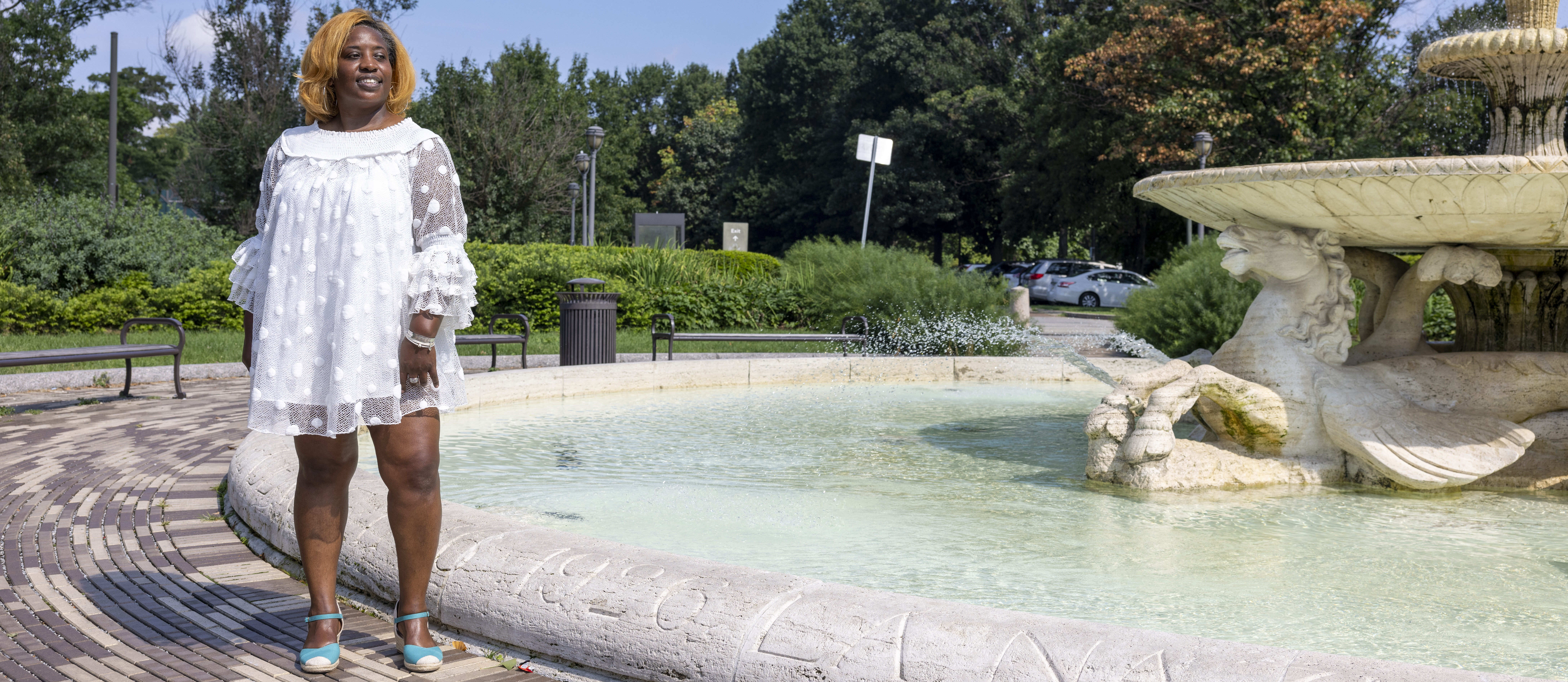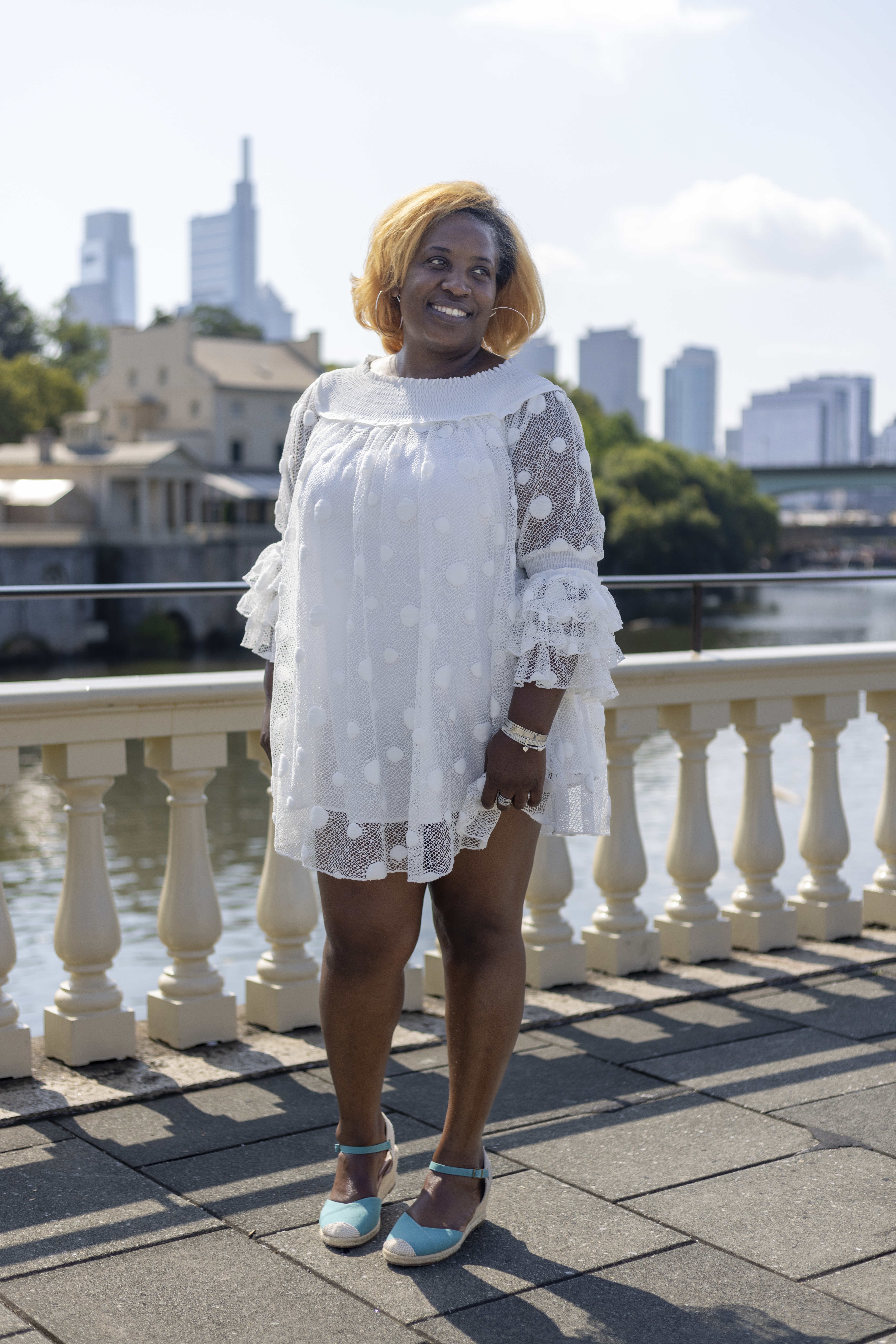
From Philly to Paris: I am the light
By: Jeneen Owens
I am forty-six years old and had never stepped foot on a continent other than the Americas. The opportunity to visit a country older than the United States came at a time when I had just experienced a major life event: I purchased my first home. Jeannine Cook, owner of Harriett’s Bookshop and Ida’s Bookshop, invited me to join her in Paris where she would curate a bookshop installation in honor of Josephine Baker. “Ma’am, I just bought a house.” “You can stay with me. Make it happen.” I could not pass up the opportunity to travel from Philly to Paris and support my sister as she solidified that “the world is [her] home.” So I, with the support of my family, made it happen.
I secretly wanted my experience to be cinematic. When I stepped off the plane I wanted there to be glitter and pixie dust in the air creating a magical feeling that would swell up in my chest, then a musical number would break out with other travelers, airport staff, and taxi drivers dancing a choreographed routine while singing an original song written and performed just for me. That was not my experience. Those breakout song and dance routines in the movies seemed so freeing and I desperately wanted to feel free. One of the reasons I decided that I could not refuse this opportunity to visit Europe was to experience a bit of freedom.
The Paris sky had a grayish hue to it although the sun shone brightly on the day I arrived. The Lutetian limestone buildings added to the feel of overcast that lingered in the air. A car service took me from the Charles de Gaulle airport to an apartment in the 3rd arrondissement on a tiny street that looked like a Philadelphia alleyway. “Nope,” said the Philly in me. Still wrapped in my hometown, I confirmed via Google Maps that I was in the correct place and checked my surroundings before stepping out of the vehicle and onto a new adventure.
Philadelphia, a sister city to Paris, lives up to its reputation in that its natives have a certain grit embedded at the cellular level. I am a Philadelphia native. There is what I refer to as a cloak of Philly that we don. We have had to develop keen observation skills and a somewhat extrasensory perception to survive each day and to thrive in our lifetime. While that “cloak” is fine at home, it isn’t always needed in the same way in different places. Who would understand this sentiment other than someone who also has also donned the cloak of Philadelphia? During a workshop Jeannine once mentioned “wearing things that you don’t need to at different times” and I felt less out of place in Paris knowing that she, too, understood the transformation that had to occur so that I could wholly experience Paris. I visited this country without knowledge of culture or language. Equipped with a few tips from Jeannine and modern technology (aka my Google Translate app) I was left to explore Paris. The pedestrian and roadway traffic reminded me of New York but, instead of a sea of yellow taxis, in Paris there were more motor scooters and bicycles on the roads. Many streets were lined with sidewalk cafes without an empty seat and musical performances just a few steps away. I wanted to know what it felt like to be a writer in Paris, to sit at a Parisian café and create. I went to the area where writers hung out long ago, where James Baldwin hung out! It felt touristy and devoid of any artistry. Treize au Jardin, the café next to Josephine’s was the perfect place for my Parisian artist fantasy though. I sat facing the Luxembourg Gardens on the other side of the street. I set up my laptop and my iPhone to record myself. I’ve never seen myself in creative mode. I wanted to see what others saw when they happened upon me in my zone.
The city was beautiful. And old. I could not help but to recall all of the movies I’d watched that depicted Paris and its culture and nod my head in agreement that the filmmakers seemed to have gotten it right. What stood out to me though, was not only the beauty and craft of the architecture but the number of beautiful Black women from the United States who were also in Paris for various reasons. Some were visiting for a week or two and some were there for the summer because that’s where their family goes every year. One professor from New York was there for two months working on her book, and a number of these Black women had made Paris their home for decades.
Josephine’s Bookshop became a home base in Paris for me. I was there to support Jeannine and also to explore the city so everyday, whether or not there was an event taking place, I would stop in before trekking off to explore. At a private event held at the bookshop, I met Camille, a Black Woman from Philadelphia who has lived in Paris for over two decades, a virtual stranger yet she was drawn to me and I to her. Her face or maybe her spirit was familiar to me. We talked for a while. She told me about living in Paris and mentioned that she missed Philadelphia. She asked to hug me as if to bring me further into the fold of sisterhood. Through our embrace, I gave her all of the hometown energy she craved and I, in turn, received another sign that I belong. Here. In this circle of sisters. Growing up in Philadelphia, this was not my experience with girls and women.

Jeneen Owen
I, like many girls, learned early on through direct and indirect lessons, that women were not to be trusted. If there is no trust established, then it is impossible to form meaningful relationships to build bonds. I believe this is by design. Competition and hate amongst girls and women were reinforced throughout my childhood and into my twenties. At 13 years old, a time when I should have been running through open fields frolicking with other children my age, I was put in direct competition with another girl a few years older than me concerning a boy who neither of us should have given the time of day. Everyone around me said that I should hate this girl yet my initial response was to empathize with her. I saw how horribly the entire neighborhood treated her. They gossiped about her and called her names. I could see the hurt she was hiding. We both were victims in this world where we were forced to grow up too quickly, where we were used, abused, and unprotected. I could see this a bit clearer than she could. But just a bit. My natural inclination was not to fight her but to sit with her, in silence, on the curb while she smoked a cigarette. We were thirteen and fifteen, respectively, grappling with adult woes.
The lessons persisted throughout my childhood into adulthood from “She thinks she cute” to “don’t trust that b’ around your man.” And most girls and women that I had come in contact with held the same beliefs, so it was difficult to form the meaningful bonds that I’d craved. Unlearning is difficult. Early on, I had succumbed to the negative messages. Byproducts of these messages, for me, were self-hate and imposter syndrome. I learned this through several avenues from the misogynistic music, to the disrespect in movies and in real life, to the very real life physical abuse and sexual harassment that I’d witnessed. This did not sit well in my spirit. This didn’t make sense to what I’d known on a cellular level: that we need each other. I’d felt this before I had the language for it.
The road to self discovery and to self-love was lonely but thankfully I wasn’t alone. I was blessed to have a few women along the way whose inner light helped to guide me on my journey as they also trekked through theirs. The journey to oneself is, ultimately, a solo mission and I sought refuge in books, in obtaining knowledge, to combat the distrust of women, the self-hate, and the imposter syndrome that early lessons taught me. I love reading. I love to gain knowledge. I love discussing topics and ideas. I love to understand others’ points of view and experiences. And I love taking all I gain to improve my life.
Paula Giddings’ book “When and Where I Enter” was instrumental in building my knowledge base and understanding of who I am supposed to be, or who I could be, or who I was or who I am. The first novel, though, that gave me a tickle of the possibility of freedom was “Their Eyes Were Watching God” by Zora Neale Hurston. Janie Crawford, a character in the book, was an example of who I could be. A free Black Woman. Her character resonated deeply within me. She did what she thought she was supposed to do, what she had to do, but ultimately chose her own path that led to her fulfillment. She wore what she wanted to wear and loved who she wanted to love. Janie found freedom in overalls and in Teacake.
I sought freedom through books to guide me in my quest to unlearn harmful lessons about women and to, ultimately, learning to love myself. So, of course, when I met Jeannine at Harriet’s Bookshop, my spirit was drawn to the bookshop keeper. As I read novels like Sula, that followed the complicated friendship between women, and Sugar, that chronicled an unlikely friendship between very different women, my perspective on life and on relationships shifted. And as my perspective of myself changed, my relationships with women also began to shift. The more I loved myself, the freer I felt; the freer I felt, the better my relationships with other women became.
I’m still a work in progress. I still suffer from imposter syndrome. I still have wavering confidence. I still question people’s motives at times and whether their compliments are genuine. I see myself differently than other people see me. It feels odd to have people genuinely be attracted to me, to my spirit, to my light. Most of my life felt as if there was a darkness surrounding me. That I needed to get to the light at the end of the tunnel.
One huge part of my journey includes the girls and women that I was able to form bonds with despite the messages we’d received. I have a few friends from childhood and early adulthood whose love has helped me to survive, to thrive, and to undo some of the harm bestowed on us. Their love and their light helped me to continue working on myself. And it was with me in Paris, urging me outside of my comfort zone as I continued to build on the work that I’d put in up to that point.
I traveled 3700 miles to find what I had been carrying all along.
